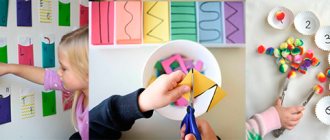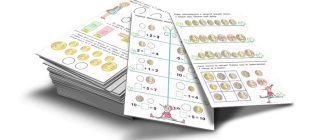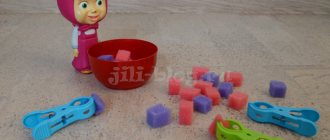Games that teach reading, sounds, letters
- Folding boxes . This game is based on the syllabic principle of Russian writing. It is a book, each spread of which is dedicated to all possible syllables with a certain consonant letter. On the same page there are pictures of animals and songs in which stressed syllables are highlighted. Folds are an improved syllabic alphabet. For the little ones there is a CD with songs included.
- Teremki Voskobovich. These are cubes based on the syllabic principle of Russian writing. The tower cubes are made of wood. There are 12 of them in total (2 of each color: white, gray, brown, purple, yellow, blue). Consonants are written on their edges. The tower cubes have windows. In these cubes you need to put cardboard chest cubes with vowels. Blue cubes for the letters A, O, U, E, Y, indicating the hardness of the consonants, green - for the letters Y, E, Yu, E, indicating the softness of the previous consonants. The same colors for hard and soft consonants are also preserved in folds.
Kids can play with the blocks as houses with windows. In each tower you can put pictures of animals (or small toys) on the letter drawn on the cube. To learn to read syllables, you need to put a chest cube in the tower cube, pronounce or sing the syllable.
- Funny letters . These are 10 cards representing vowels. They all depict Harlequin in different poses. They are called wittily: Harlequin, Urlekin, Orlekin, etc. They help develop imagination and remember the image of a letter.
- Reader on marbles . This is a square that you need to bend along the lines while reading the words. You can read up to 130 words.
- Lacing games for teaching reading: “Apple Tree”, “Snowman”, “Chamomile”. These are lacing of different shapes that connect letters into words. A child who does not know letters can play with them, just like lacing.
- The letter constructor introduces the “look” of each letter. There are rubber bands attached to the plywood base. Under these rubber bands, children insert the parts from which they make letters. There are 15 parts in total, different shapes. The creation of letters is accompanied by a fairy tale about adventures in the Violet Forest. It is the fairy tale that establishes the connection between letter and sound.
Games for children from 4-5 years old
All of the above games are also suitable for children of older preschool age, but they are played differently. The goal of this age: knowledge of the world and its laws in the game. The game "Geocont" gives an idea of colors, sizes and shapes, and teaches how to compare shapes by shape. The games “Voskobovich Square” and “Miracle Crosses” teach you how to create models using diagrams. The game "Plop-Plop Boat" gives an idea of the division of objects by color and quantity. The game “Folds” teaches you to divide a word into syllables and distinguish between vowels and consonants. The games “Chamomile”, “Snowman”, “Apple Tree” help with the help of lacing to form words from letters, and the game “Letter Constructor” makes it possible to remember the letters themselves. The game “Math Baskets” gives an idea of the composition of a number (you need to add mushrooms to the basket up to ten), prepares the pen for school (the child traces and shades, colors the mushrooms). The game “Teremki Voskobovich” is a unique simulator for teaching reading. The basis is syllables, not letters, as in traditional cubes.
The game "Reader on Balls" strengthens reading skills. Depending on the fold line, you can read short (2 letter) or long (6 letter) words (up to 130 words in the game). The game “Miracle Flower” gives the initial concept of fractions (parts of a whole) and teaches them to distinguish colors.
Games that teach numbers, counting, multiplication and other mathematical operations
- The ship "Plop-Plop". This is a three-dimensional plywood boat with wooden masts, numbered from 1 to 5, on which you need to put flags of the same color on each one. The game is accompanied by a fairy tale about a captain and a sailor, Goose and the Frog.
- The Splash-Splash boat . This is a flat boat on a carpet playing field with a deck glued on it. Each mast corresponds to a number from 1 to 7. You need to attach flag sails to it with Velcro of different colors.
- Boat "Bul-bul" . It is also flat, but it has ten masts. Accordingly, you can learn counting up to 100, four mathematical operations. The boat comes with tasks of varying difficulty.
- Math baskets . This game comes in different difficulty levels. You can put up to 10 mushrooms in each basket. A child collects mushrooms along with number animals. He must estimate how many mushrooms need to be added up to a dozen, and compares who has more mushrooms. The game gives an idea of the composition of numbers and teaches mathematical operations.
- Set of cards " Funny numbers ". Each number has the image of some animal. Cards develop imagination and help remember the image of a number.
- Transparent number . This game consists of stripes on a transparent film. The child must create numbers from them. Forms spatial thinking and combinatorics. Somewhat similar to the “Letter Constructor”, but made from different materials.
- Miracle flower . The game consists of plywood flowers, divided into parts. The child puts together a whole from parts, as well as figures according to the instructions.
- The “ Counting ” lace-up activity teaches addition and subtraction to up to 20 children aged 4 years and older. Can be used simply as lacing.
- Planet of multiplication . This is a game for a group of preschoolers or primary schoolchildren. During the game you can learn multiplication. You need to get to the spaceship through your shaft, alternating moves. Multiplication will be needed when counting votes.
Educational games Voskobovich article on mathematics on the topic
Educational games by Voskobovich
The first games of Vyacheslav Voskobovich appeared in the early 90s. Basically, these are construction games and puzzles, accompanied by fairy-tale plots.
The most famous of them are “Geokont” and “Voskobovich Square”.
Games develop design abilities, spatial thinking, attention, memory, creative imagination, fine motor skills, the ability to compare, analyze and contrast. There are also more complex games that teach children to model and relate parts and the whole.
In such games, children comprehend theory through practice. The author has also created manuals aimed at learning numbers (for example, “The Magic Eight”) and letters (“Letter Constructor”), and for learning to read (for example, using the universal textbook “Folds”). Voskobovich's games are multifunctional and are intended for children from 2 to 10 years old (although they can be up to 99 years old).
A little history
Vyacheslav Vadimovich Voskobovich - lives in St. Petersburg. He has developed more than 40 educational games and manuals. In the past, Vyacheslav Vadimovich was an engineer-physicist.
The impetus for the invention of games came from two of his own children and “empty” toy stores during the era of Perestroika. Voskobovich, trying to find an alternative to the usual post-Soviet toys, came across the experience of Nikitin and Zaitsev, but decided to go his own way. This is how his first creative games appeared: “Geokont”, “Game Square”, “Color Clock”.
“We abandoned “disposable” products: assembled, disassembled and put aside, we create universal games that can be creatively used repeatedly,” says Vyacheslav Voskobovich.
A little later it was created for the development, production, implementation and distribution of methods and developmental and correctional games.
Goals of classes with Voskobovich game materials
• Development of the child's cognitive interest and research activity.
• Development of observation, imagination, memory, attention, thinking and creativity.
• Harmonious development of emotional-imaginative and logical principles in children.
• Formation of basic ideas about the surrounding world, mathematical concepts, sound-letter phenomena.
• Development of fine motor skills.
Features of Voskobovich's educational games
— The games are designed based on the interests of children.
By playing with such gaming aids, children get real pleasure and discover more and more new opportunities for themselves.
— Wide age range.
Children from 2 to 7 years old and older can play the same game.
The game begins with simple manipulation and then becomes more complex due to a large number of different game tasks and exercises.
— Multifunctionality and versatility.
By working with only one game aid, the child has the opportunity to show his creativity, develop comprehensively and master a large number of educational tasks (get to know numbers or letters, colors or shapes, counting, etc.).
— Ready-made educational didactic material, systematized by age and educational objectives.
— Methodological support.
Many games are accompanied by special methodological books with fairy tales, in which various plots are intertwined with intellectual tasks, questions and illustrations. Fairy tales and their good heroes - the wise raven Meter, the brave little Geo, the cunning but simple-minded Vse, the funny Magnolik - accompanying the child through the game, they teach him not only mathematics, reading, logic, but also human relationships.
Voskobovich's most popular games
“ Geokont ” - it is also called a “plate with nails” or “multi-colored cobwebs” -. It is a plywood board with a coordinate film applied to it. Plastic nails are attached to the playing field, onto which multi-colored “dynamic” elastic bands are pulled. As a result of this design, object silhouettes, geometric shapes, patterns, numbers, and letters are obtained.
The game set is accompanied by the methodological fairy tale “Little Geo, Raven Meter and Me, Uncle Slava” (the word “geometry” is encrypted in the title of the fairy tale).
And the fairy tale begins like this: “One day, little Geo had a dream. He walks around the world for a day, a second, a third, and suddenly he meets the Red Beast. The kid got scared, ran, and suddenly - a voice: “Don’t be afraid of the Red Beast, drive him away with an orange cry.” The baby shouted with an orange cry - the Red Beast disappeared, but a tree appeared, on the top of which the Yellow Bird sat. The Yellow Bird flapped its wings and circled, the Kid got scared and ran. And again the voice: “Don’t be afraid of the Yellow Bird - drive it away with a green whistle.” The baby whistled with a green whistle - the Yellow Bird disappeared. A lake appeared and a boat stood on the shore. The Kid got into the boat, made a few strokes, and suddenly a Blue Fish swims out. The Kid got scared again and leaned on the oars, but that was not the case. And again the voice: “Don’t be afraid of the Blue Fish, drive him away with a blue whisper.” The Kid whispered in a blue whisper - the lake disappeared, the boat disappeared. Geo stood in front of the entrance to the Violet Forest."
Thus, the baby does not just create images on Geokont, but makes the web of the Yuka spider, rays and segments, which are called the “orange cry of the Red Beast,” “the green whistle of the Yellow Bird,” or the “blue whisper of the Blue Fish.” The book contains diagrams and drawings of what a child should achieve.
As a result of playing with “Geokont”, children develop motor skills of the hand and fingers, sensory abilities (mastering color, shape, size), mental processes (designing according to a verbal model, constructing symmetrical and asymmetrical figures, searching for and establishing patterns), and creativity.
“Voskobovich Square” or “Game Square” can be 2-color (for children 2-5 years old) and 4-color (for 3-7 year old children)
The game consists of 32 rigid triangles, glued on both sides at a distance of 3-5 ml from each other on a flexible fabric base. On one side the “Square” is green and yellow, on the other – blue and red. The “square” is easily transformed: it can be folded along fold lines in different directions according to the “origami” principle to obtain three-dimensional and planar shapes. That is why this game is also called “Eternal Origami” or “Transformer Square”.
The game is accompanied by a methodological tale “The Mystery of the Raven Meter, or the tale of the amazing transformations and adventures of a square.” In it, “Square” comes to life and turns into various images: a house, a mouse, a hedgehog, a kitten, a boat, a shoe, an airplane, candy, etc. The child collects figures from pictures in a book that shows how to fold a square and gives an artistic depiction of the same object.
This square puzzle not only allows you to play, develop spatial imagination and fine motor skills, but is also a material that introduces the basics of geometry, steriometry, counting material, the basis for modeling, creativity, which has no age restrictions.
"Miracle=crosses" is a game with inserts. The inserts are made of circles and crosses. The crosses are cut into pieces in the form of geometric shapes. At the initial stage, children learn to assemble cut shapes into a single whole. Further, the task becomes more complicated: according to the diagrams in the “Album of Figures” (attached), the child first collects paths, towers, and then dragons, men, soldiers, insects and much more.
The game develops attention, memory, imagination, creativity, “sensory” (distinguishing the colors of the rainbow, geometric shapes, their size), the ability to “read” diagrams, compare and make a whole from parts.
“The ship “Splash - Splash ” is a playing field made of carpet in the form of a ship with a glued plywood hull and printed numbers from 1 to 7. To the mast on the hull you need to attach the colors of the rainbow and the required number of velcro flags - sails. The game develops fine motor skills, attention, memory, thinking, gives an idea of mathematical concepts, color, height, spatial arrangement of objects, conventional measurement, number of objects, their serial number and digital series.
“Math Baskets” - this manual will help your child literally “touch” counting, understand the composition of numbers, and also understand the meaning of addition and subtraction. The baby needs to put a certain number of mushroom inserts into baskets with different numbers of recesses. According to the fairy tale, a child, together with the little animals: Hedgehog-One, Bunny-Two, Mouse-Three and others, collects mushrooms in baskets, counts them, distributes an equal number of mushrooms to the animals and checks who has full baskets and who doesn’t. The animals collect mushrooms, and the baby finds out who has collected more and who has collected less.
“Funny Letters” are cards with images of the vowels of the Russian alphabet in the form of acrobat jesters: the first jester curved like the letter A and his name is Harlequin, the other jester twisted like the letter O and his name is Orlekin, U appears to be Urlekin, there are also Jarlekin, Yrlekin, Yurlekin, etc. By playing with cards and singing the names of jesters, the child becomes familiar with letters and practices sound analysis of words; develops attention, memory, thinking, imagination and speech.
"Voskobovich's Teremki" is a unique tool for teaching reading on a visual basis. The game consists of 12 wooden chest cubes of different colors (2 white, 2 blue, 2 yellow, 2 purple, 2 brown) with consonant letters on the edges, as well as 12 cardboard chest cubes (2 blue, 2 green, 6 double blue -green, 2 symbolic) with vowels on the edges, which are put into tower cubes to form syllables. And from several “teremki” you can make a word.
At the first stage of the game, the child becomes familiar with sounds and letters. On the faces of the first white cube there are the letters B, P, V and F. The child turns the cube in different directions and names the sounds. Then he comes up with what animals could live in this little house: a butterfly, a parrot, a wolf, an eagle owl. In the same way, the child gets acquainted with the rest of the “teremkas”.
Now the insert cubes with jester vowels are connected. The blue cube contains A, O, U, E, Y (vowels showing the hardness of the sound), and the green cube contains I, Yo, Yu, I, E (vowels showing the softness of the vowel sound).
At the second stage, we learn to form syllables. We put a cube with the letter A into the first “terem” and read the resulting syllable: “Pa.”
At the third stage, you can compose and read simple words. The device of the tower cubes allows you to turn the process of learning to read into a series of exciting games. For example, a game of “transformers”, where “house” can easily become “smoke”, and “ice” into “honey”.
"Folding boxes." Voskobovich reworked the idea of Zaitsev's warehouses, who created cubes with warehouses.
The game-aid “Skladushki” is intended for teaching children to read in a storage system.
The manual is made in the form of a book, on each page there is a bright picture and a poetic caption with highlighted sections. There is also a CD with voiced warehouse songs, for example, one of them:
Goose and goose There were only a dozen goslings. The goose and the goose were shortchanged. Everyone was there.
What you should pay attention to when working with your child on Voskobovich’s games:
• Preparation. Before offering the game to your child, read the guidelines and the game itself.
• Speech. Mostly children work with their hands and speak little. During classes, ask your child what he is doing, why he chose this particular figure and not another, ask him to retell the fairy tale task or come up with his own plot.
• Static. When engaging with play materials, the child is most often in the same sitting position. It is necessary to take into account the age characteristics of children and promptly distract them from sitting for too long.
• Perseverance. Playing with Voskobovich's manuals requires perseverance, and not every child likes or is able to do this.
How to play Voskobovich games
You need to carefully study the rules of the game and its fairy tale basis (after all, you will have to read the fairy tale or tell it to your parents). It is best to follow the methodological recommendations, complete the task one at a time, gradually complicating the game. There are parents who don't like to read instructions. They can play with the child as they please, and this will also be interesting and useful, but it is unlikely that the full potential of the game will be used.
If you are going to play Voskobovich’s games, it is better to purchase at least three games: educational, teaching reading and mathematics.
Voskobovich's games do not develop speech if the child plays them independently. Therefore, it is better to take part in his games and ask about the order and purpose of his actions, ask him to retell the plot of the fairy tale.
Games can be classified as board games (or “wall games”), so they do not contribute to the physical development of the child, but only to the intellectual and psychological. Parents themselves must take care of physical exercise. Remember that even a six-year-old child cannot concentrate on anything for more than 15 minutes.
How are classes conducted using the Voskobovich method?
Before starting classes, be sure to read the methodological recommendations and instructions for the Voskobovich game that you bought for your baby. It is very important not to force your child to complete certain tasks in the game. The child must determine the pace and level of load himself, independently switching from one task to another.
Since Voskobovich’s games assume that the child will sit in one place for some time, the author of the technique advises that at first, classes should last about 10 minutes. After a short break, when the child runs around a little, you can return to completing tasks.
Voskobovich's fairytale method is built on trusting and friendly relationships between the child and parents, when adults and children are partners and support and help each other in everything. Therefore, if your child doesn’t succeed in something the first time, there is no need to criticize him. Praise your child more often, and rejoice at his every victory (even if it is insignificant).
In the process of completing tasks, children almost all the time work only with their hands and interact very little with the environment. In order for the child to develop not only memory, logic, thinking, motor skills, etc., but also speech, Vyacheslav Vadimovich Voskobovich recommends asking the child to comment on all his actions or retell the plot of a fairy tale. Ask your child as many questions as possible about what fairy-tale task he is performing now, and what options for completing it he has already come up with.
Disadvantages of Voskobovich's games
And there are no shortcomings. There are always children for whom a certain technique is not suitable. Voskobovich's games are suitable for everyone. And this can be explained: in preschool age, play is the main activity of a person; in play he lives, grows, develops and learns. Therefore, the game is suitable for everyone.
Children studying according to the Voskobovich method usually show a good level of development of memory, thinking, attention, as well as the ability to concentrate on the task at hand and bring it to the end. These children have a well-developed desire to learn and explore something new, which is important for the learning process at school.
Features of the Voskobovich technique
The author of the methodology is absolutely sure that all children quickly and happily master new knowledge and skills only if the learning process takes place in a fun and relaxed atmosphere. Voskobovich his on such principles as:
- cognitive process - each game is a separate fairy tale, filled with funny characters and adventures that promote the development of imagination and logic;
- creativity – non-traditional tasks in games form creative thinking in the child and develop creative potential;
- learning – while playing, the child simultaneously remembers letters, numbers, shapes, colors, etc.
That is, Voskobovich’s educational games are a multifunctional tool that allows children to successfully develop logic, memory, thinking, motor skills and other psychological processes in a playful form, as well as teach them counting and reading. It is noteworthy that Voskobovich’s games are intended for children in a wide age range: both children 1-2 years old and elementary school students play them with pleasure. At the same time, parents do not necessarily need to purchase new games as their child grows older. Due to the fact that each game contains many tasks (from simple manipulation of elements to solving complex multi-level problems), a game purchased once will be of interest to a child for several years.
Almost all of Voskobovich's games are accompanied by teaching aids , including fascinating fairy tales with bright illustrations, which contain tasks interesting for children.
Telling fairy tales using the square of V. V. Voskobovich
Aigul Zainutdinova
Telling fairy tales using a square by V.V. Voskobovich
Telling fairy tales using a game square by V. V. Voskobovich .
The game square consists of 32 rigid triangles glued to a flexible base on both sides. Thanks to this design the square can be easily transformed, allowing you to design both planar and volumetric figures. The square can be two or four colors.
By folding a square, you can introduce children to geometric shapes such as square , rectangle, triangle and their properties. By playing with a square, children develop imagination, attention, logic, thinking, and memory. Also, games with the Voskobovich square contribute to the development of children's speech. By playing the Voskobovich square, children compose their own story.
Our goal is to introduce children to the Voskobovich square ; develop thinking, imagination, speech using innovative technologies.
When we started working with the Voskobovich square, we focused on telling familiar fairy tales using the square (Teremok, Cinderella)
, and also invited the children to fantasize with
the square and compose their own fairy tale .
We started working with square B. V. Voskobovich from the middle group , but we believe that it can also be used for younger children. Working with square B. V. Voskobovich , we developed the imagination of children, giving them the opportunity to fantasize, we offer the beginning of a fairy tale , and the children continue it in turn. (for example: Once upon a time there was a square and one day he ended up in the forest) children begin to fantasize about what could happen the square In this way, imagination and speech develop, children become liberated and are not afraid that they will say that something is wrong, because this is their fairy tale .
In addition, children can compose their own fairy tale . Also, working with a square, we suggest telling an already familiar fairy tale , for example “Teremok”
in this case, we offer children diagrams for folding
a square . Children, when telling a fairy tale , put together a house , candy, etc. from a square. In this way, fine motor skills of the hands develop.
, mostly children tell familiar fairy tales using square B. V. Voskobovich , inventing and changing the plot of a fairy tale . Then continuing to work with square B. V. Voskobovich in the senior and preparatory school groups, we propose to come up with and tell a fairy tale about “Cinderella”
This is a familiar
fairy tale , children telling it can change the plot of the fairy tale . And then the children independently come up with and act out their own fairy tale using square B. V. Voskobovich . We introduced B squares . V. Voskobovich made with his own hands, two and four colors. Children have the opportunity to take squares and play them independently.
Game squares B. V. Voskobovich not only for telling fairy tales , but also in educational activities.
We consider the use of squares B. V. Voskobovich has a beneficial effect on the development of preschool children, helps develop imagination , thinking, fine motor skills, and speech.
“Fairytale lesson” or introduction to the fairy tale “Winged, Shaggy and Oily” using a transparent square by V. Voskobovich Purpose: To introduce children to the Russian folk tale “Winged, Hairy and Oily” and help them understand its meaning. Objectives: Educational: To introduce.
Summary of OOD on FEMP using educational games by V.V. Voskobovich in the middle group “Wonderful transformations of a square” on the topic: “Wonderful transformations of a square based on the fairy tale by V.V. Voskobovich “The Mystery of the Raven Meter, or the Tale of Amazing Adventures of Transformations.”
Summary of the game OOD on FEMP with the help of educational games by V.V. Voskobovich in the middle group “Journey to the Digital Circus” on the topic: “Journey to the Digital Circus” together with parents Goal: to attract the attention of parents to their intellectual and creative development.
Abstract of the GCD for FEMP “Dividing a square into two equal parts” Topic: “Dividing a square into 2 equal parts” Goal: developing in children positive motivation for learning, FEMP. Ability to divide a square into two.
Summary of a lesson on speech development “Teaching children to tell Russian folk tales using a matrix picture” Goal: developing the ability to tell a fairy tale using a matrix picture. Objectives: Educational: to develop children’s ability to tell stories.
Summary of a lesson on speech development “Teaching children to tell Russian folk tales using visual modeling” Department of Education of the Nizhny Novgorod City Administration Municipal budgetary preschool educational institution “Kindergarten.
Lesson summary “Three squares” “Three squares” Purpose: to teach children to correlate three objects by size and indicate their relationships with the words: “big”, small”, “medium”.
Telling and modeling fairy tales using mnemonic tables. OOD in the middle group “Fairy Tale Confusion” OOD – in the middle group “Fairy Tale Confusion” Telling and modeling fairy tales using mnemonic tables. Goal: Teach children to restore.
Development of mental abilities of children of senior preschool age with the help of games by V.V. Voskobovich Voskobovich's Square is an educational fairy tale for a preschooler. Most modern toys are disposable and useless, they are quick.
Lesson on FEMP. Topic: “In the country of square and triangle” Lesson on FEMP. Topic: “Journey to the land of squares and triangles” Purpose: to teach children to distinguish and correctly name a square and a triangle;
Source
Author of the method
V.V. Voskobovich, a physicist and mathematician by training, discovered his talent as a teacher and methodologist in the early 90s. During a period of shortages in stores, with modest financial resources, he raised two sons. Their development required the manifestation of imagination. Voskobovich's first games were created based on the works of Zaitsev and Nikitin.
A sweet hobby eventually turned into a lifelong endeavor. Within a few years he founded the methodical. The author actively conducts seminars on the implementation of his own methodology in the educational process, develops and distributes new games (today there are more than 50 variations). Voskobovich calls his games for preschoolers technology or “Fairytale labyrinths of games.” Having become an innovative teacher, he made a tangible contribution to the methodological collection of pedagogy during the crisis.









